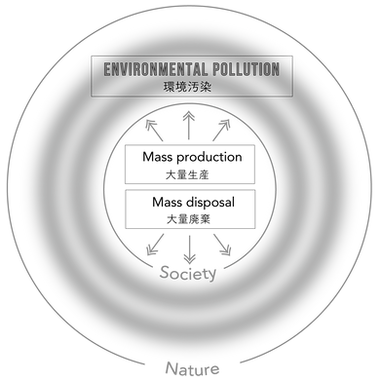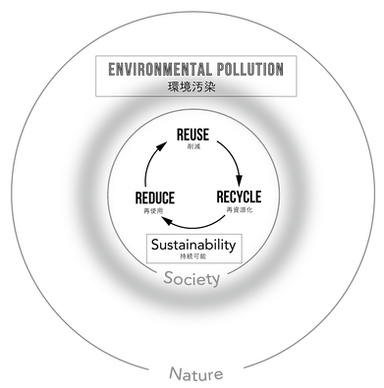変化する時代
地球温暖化、気候変動、森林破壊、海洋汚染、大気汚染など世界が抱える様々な環境問題。
それまでは一部の分野や個人が問題視していた社会課題でしたが、2015年の国連サミットで持続可能な開発目標(SDGs)が採択されたことで世界が一体となって取り組む必要があると認識されてからは様々な企業がサスティナビリティな考えを基礎とした方向に向かっています。
私たちの生活基盤である「衣食住」の各分野では、生物多様性への配慮として化学薬品を使わないオーガニック食材や輸送エネルギーを使わない地産地消、住宅では省CO2・節電・再生可能エネルギー(太陽光)など環境への負担が配慮されている動きが徐々に身近になってきています。
近年、環境汚染を引き起こす大量生産・大量廃棄が行われているファッション業界でもエシカル・サスティナブルなファッションの普及に取り組む企業が世界的に増えてきました。
ファッション業界が排出しているCO2の量は人類が地球上で活動する10%を占め、染色や仕上げに大量の水を消費することから世界の工業用水汚染率としては17~20%にものぼると推定されています。
また、製造された衣類は年間約8000万tものごみとして処分・焼却されることで地球温暖化を助長し、生産汚染から廃棄汚染まで様々なことが環境問題となっています。
具体的な取り組みとしてREDUCE(削減)・REUSE(再使用)・RECYCLE(再資源化)を基礎に考え、環境負荷の低い天然素材を積極的に取り入れることで、大量生産・大量消費の時代から徐々に持続可能な業界に変化を遂げようとしています。
Changing times
The world faces a variety of environmental issues, including global warming, climate change, deforestation, marine pollution, and air pollution.
Until now, these were social issues that only certain sectors or individuals considered problematic. However, the adoption of the Sustainable Development Goals (SDGs) at the 2015 United Nations Summit recognized the need for global collaboration and has since led many companies to move in a direction based on sustainability.
In the areas of "food, clothing, and shelter," which form the foundation of our lives, environmentally conscious movements are gradually becoming more common, such as considering biodiversity through the use of organic ingredients (free from chemicals) and local production and consumption (which reduces transportation energy), and in housing, reducing CO2 emissions, saving electricity, and using renewable energy (solar).
In recent years, even in the fashion industry, where mass production and waste often cause environmental pollution, an increasing number of companies worldwide are working to promote ethical and sustainable fashion.
The fashion industry accounts for 10% of human activity on Earth, and the large amount of water consumed in dyeing and finishing processes is estimated to account for 17-20% of global industrial water pollution.
Furthermore, approximately 80 million tonnes of manufactured clothing are disposed of or incinerated as waste each year, contributing to global warming, and various environmental issues arise from production pollution to waste pollution.
Specific initiatives based on the principles of REDUCE, REUSE, RECYCLE, and actively incorporating natural materials with a low environmental impact, are gradually moving away from the era of mass production and mass consumption to a more sustainable industry.


なぜ鹿を革として使うのか
現代の日本人のような暮らし方を世界中の人々がした場合、地球が 2.4 個必要と言われています。
近代化する私たちの暮らしは 1人当たりの生活を維持するのに必要な地球の環境容量を遥かに上回り、生態系の回復が消費に追いついていない状況です。
皮革市場の9割を占めると言われる重金属系薬品を使用したクロム鞣しは原料コストも低く、革の能性を高めてくれる便利な発明でした。
しかし、使用する薬品は人体に有害なうえ、工業排水として川を汚染してしまうデメリットが含まれています。
人や社会にとって便利なものは自然環境へ代償を払わせてしまう。
環境を第一に考えると社会発展は困難を極めてしまう。
「社会」と「自然」の発展は相反する関係性にあります。
縄文時代から存在が確認されている「日本鹿」は、人為的な遺伝子交配の影響も受けず数万年前から原生的な食物連鎖のなかで今もなお現存し、自然界との根源的な繋がりをもった日本の森を象徴する野生動物の一種です。
草食動物である鹿は山に自生する草や樹皮を食していますが、鹿の唾液には樹木を枯らしてしまう菌が含まれ、皮を食べられた樹木はいずれ倒木し、循環していた山のサイクルは徐々に荒廃の一途を辿ってしまいます。
私たちは原料の皮を精肉工場からではなく、個体数を調整するハンターから直接譲り受けることでハンター促進のインセンティブとなり、鹿の食害による森林消失の減少、ストレスのない環境容量向上と同時に、売り上げの一部を森林のリカバリーに充てることで自然界と社会が共に発展してゆく新たな循環を生み出すことを理念としています。
野山から得たすべての天然皮は、生産過程から工業排水まで環境に配慮された日本のタンナー工場にて生産します。
一頭づつの革にはトレーサビリティを完備し、いつ・どこで・どのように生きている個体なのかプロセスを明瞭に理解することが可能で、自然の土へ還すことも出来るエコレザーとして敏感肌の方や赤ちゃんでも安心してお使い頂ける身近な素材へ転換されます。
REDUCE(削減)・REUSE(再使用)・RECYCLE(再資源化)といった社会の中だけの循環を飛び越えて、山から得た資源を、物流を通し、再び自然界の山へ還すことにより、私たちを含めた生物全体が根本的な関係性の改善へ向かうことを期待しています。
Why use deer for leather
It is said that if everyone in the world lived the way modern Japanese people do, we would need 2.4 Earths.
Our modernizing lifestyles far exceed the Earth's environmental capacity needed to sustain a per capita lifestyle, and ecosystem recovery is not keeping up with consumption.
Chrome tanning, which uses heavy metal chemicals and accounts for approximately 90% of the leather market, is a convenient invention that not only reduces raw material costs but also enhances the performance of leather.
However, the chemicals used are harmful to the human body, and industrial wastewater pollutes rivers.
Things that are convenient for people and society come at a cost to the natural environment.
Social development becomes extremely difficult when the environment is prioritized.
The development of "society" and "nature" are in an opposing relationship.Confirmed to have existed since the Jomon period, Japanese deer have survived tens of thousands of years in a pristine food chain, unaffected by artificial genetic breeding. They are a wild animal symbolizing Japan's forests, with their fundamental connection to nature.
As herbivores, deer feed on grasses and bark that grow naturally in the mountains. However, their saliva contains bacteria that can kill trees. Trees whose bark is eaten eventually fall, gradually destroying the natural cycle of the mountains.
We source our hides directly from hunters, who control the population, rather than from butchers. This provides an incentive for hunters, reduces deforestation caused by deer feeding, and improves the stress-free environment. At the same time, we allocate a portion of our sales to forest restoration, creating a new cycle in which nature and society thrive together.
All natural hides obtained from the mountains and fields are produced in Japanese tanneries, where environmental considerations are taken into account from the production process to industrial wastewater disposal.
Each animal's leather is fully traceable, allowing us to clearly understand the process, including when, where, and how the individual lived. It is then converted into eco-leather that can be returned to the soil, making it a familiar material that is safe for people with sensitive skin and babies.
By going beyond the cycles of reduce, reuse, and recycle that only exist within society, and returning resources obtained from the mountains through logistics to the mountains, we hope to fundamentally improve the relationships between all living things, including ourselves.
